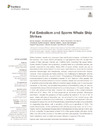Please use this identifier to cite or link to this item:
https://accedacris.ulpgc.es/handle/10553/69954
| Title: | Fat embolism and sperm whale ship strikes | Authors: | Arregui Gil, Marina Bernaldo de Quirós Miranda, Yara Sierra Pulpillo, Eva María Suarez Santana, Cristian Manuel Arbelo Hernández, Manuel Antonio Diaz Delgado, Josue Puig Lozano, Raquel Patricia Andrada Borzollino, Marisa Ana Fernández Rodríguez, Antonio Jesús Saavedra Santana, Pedro |
UNESCO Clasification: | 3105 Peces y fauna silvestre 310907 Patología |
Keywords: | Antemortem Canary Islands Fat embolism Sperm whales Ship strikes |
Issue Date: | 2019 | Journal: | Frontiers in Marine Science | Abstract: | Strikes between vessels and cetaceans have significantly increased worldwide in the last decades. The Canary Islands archipelago is a geographical area with an important overlap of high cetacean diversity and maritime traffic, including high-speed ferries. Sperm whales (Physeter macrocephalus), currently listed as a vulnerable species, are severely impacted by ship strikes. Nearly 60% of sperm whales' deaths are due to ship strikes in the Canary Islands. In such cases, subcutaneous, muscular and visceral extensive hemorrhages and hematomas, indicate unequivocal antemortem trauma. However, when carcasses are highly autolyzed, it is challenging to distinguish whether the trauma occurred ante- or post-mortem. The presence of fat emboli within the lung microvasculature is used to determine a severe "in vivo" trauma in other species. We hypothesized fat emboli detection could be a feasible, reliable and accurate forensic tool to determine ante-mortem ship strikes in stranded sperm whales, even in decomposed carcasses. In this study, we evaluated the presence of fat emboli by using an osmium tetroxide (OsO4)-based histochemical technique in lung tissue of 24 sperm whales, 16 of them with evidence of ship strike, stranded and necropsied in the Canaries between 2000 and 2017. About 70% of them presented an advanced autolysis. Histological examination revealed the presence of OsO4-positive fat emboli in 13 out of the 16 sperm whales with signs of ship strike, and two out of eight of the "control" group, with varying degrees of abundance and distribution. A classification and regression tree was developed to assess the cut offof fat emboli area determining the high or low probability for diagnosing ship-strikes, with a sensitivity of 89% and a specificity of 100%. The results demonstrated: (1) the usefulness of fat detection as a diagnostic tool for "in vivo" trauma, even in decomposed tissues kept in formaldehyde for long periods of time; and (2) that, during this 18-year period, at least, 81% of the sperm whales with signs of ship strike were alive at the moment of the strike and died subsequently. This information is highly valuable in order to implement proper mitigation measures in this area. | URI: | https://accedacris.ulpgc.es/handle/10553/69954 | ISSN: | 2296-7745 | DOI: | 10.3389/fmars.2019.00379 | Source: | Frontiers in Marine Science [ISSN 2296-7745], v. 6 (JUL) |
| Appears in Collections: | Artículos |
Items in accedaCRIS are protected by copyright, with all rights reserved, unless otherwise indicated.
